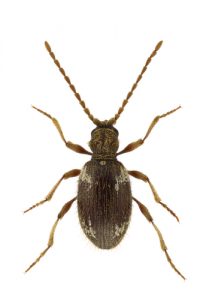Spider Beetles Kind Of Look Like Spiders
By Chris Williams on April 6, 2012.
Q. We apparently have an unusual pest in our home. We’ve found several of these tiny, shiny red things that look like little spiders or mites. They’re about the size of the head of a pin. I thought maybe they were clover mites but our county extension agent said they’re spider beetles. Do they suck blood, and why do we have them in our house?
A. You’re right, spider beetles are rather unusual. There are many different types of spider beetles but the one that you have is commonly called a “hump beetle.” Some spider beetles, like the hump beetle, have a rounded body that is shiny and a dark blood-red color. Consequently, many people mistake them for ticks or other blood-sucking pests. These beetles don’t suck blood or bite. There are other related spider beetles that look totally different; some are hairy instead of being shiny. 
If you have a magnifying glass, you would see that spider beetles have only 6 legs, not the 8 legs of spiders or mites. Also, spider beetles have a pair of long antennae; spiders don’t. Spider beetles get their name not because they’re related to spiders but because they have rounded bodies with long legs. The head is usually bent downward so, from the top, they look like tiny spiders or mites.
Spider beetles are scavengers on plant and animal materials. That means that they will feed on just about anything. They’re considered minor pests of stored grains and stored foods because they develop slowly and usually infest food products that are already old, damp, or damaged. To look for the source of the infestation, check any old, damp, grain-based food products like flour, cornmeal, oatmeal, cereals, and bran. Those that have been forgotten at the back of the cupboard or the bottom of the pile are most likely to be infested. Also check dried fruits, nuts, dried beans and peas, and spices. Stored dry pet food is another likely infestation site.
Spider beetles are usually active at night, hiding during the day. The larvae of spider beetles are small, C-shaped grubs. They cover themselves with silken threads to which they attach food particles. Mature larvae have been known to bore into wood or packaging materials looking for a protected place to pupate.
Spider beetles don’t just feed on food products however. Some feed on animal hair and feathers and can damage stuffed animals, furs, or hides. Spider beetles can also be found developing in birds’ nests, and in pet, bird, or rodent droppings. In fact, spider beetles are sometimes the first clue that there is a rodent problem. These scavenger beetles also feed on accumulations of dead insects like overwintering cluster flies or lady beetles in an attic. Since spider beetles feed on so many different types of things, you might want to contact a pest control professional who can narrow down possible infestation sites.